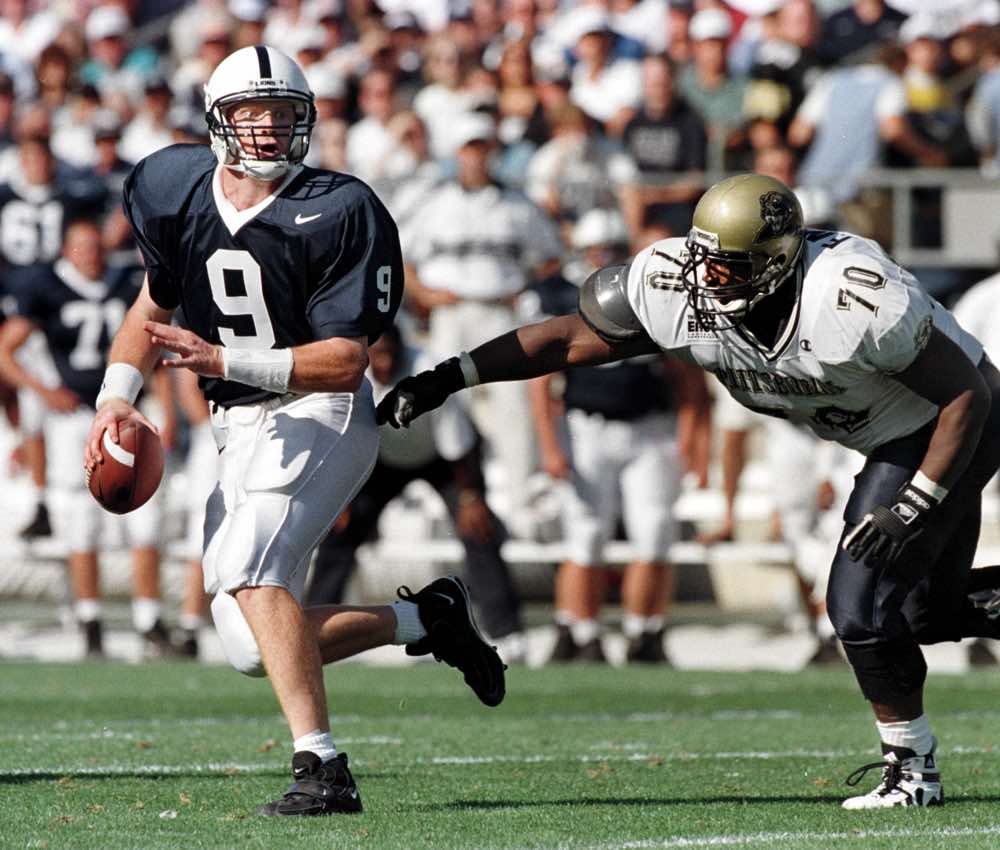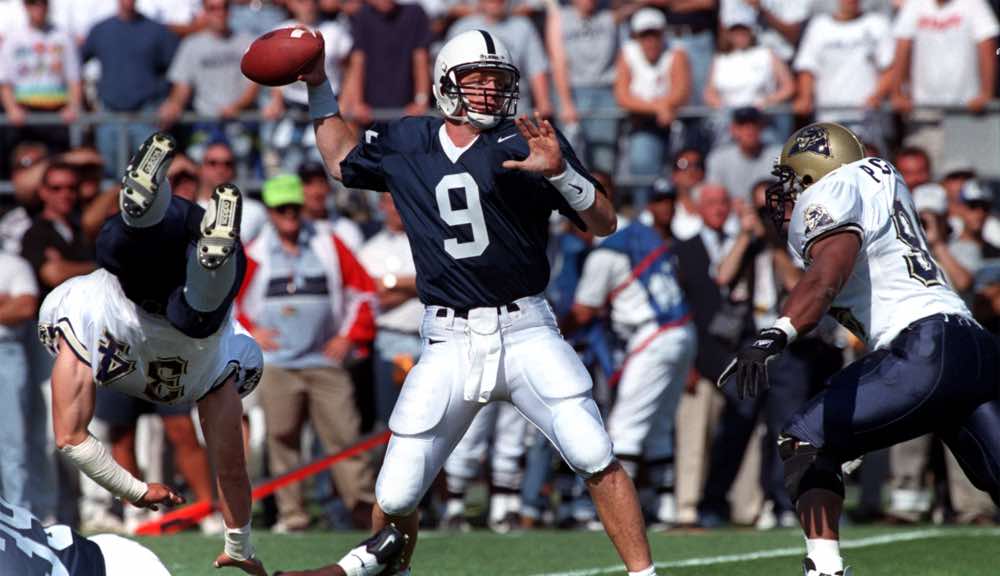By Craig Meyer/Pittsburgh Post-Gazette
On Sept. 12, 2000, four days before his team was scheduled to play the University of Pittsburgh, Justin Kurpeikis opened his mailbox on the Penn State campus. Inside, the Nittany Lions defensive lineman and Central Catholic High School graduate discovered a postcard with a simple, albeit loaded, message.
“We’re going to teach you a lesson in the shadows of the Cathedral of Learning,” it read.
What the letter lacked in geographic accuracy — the college football game was played at Three Rivers Stadium, 4 miles west of Pitt’s iconic 42-story tower — it made up for in inflamed, uninhibited passion, the kind that compels someone to send such a note to a stranger (a college student, no less).
Even while the Pitt-Penn State rivalry was dormant for 16 years, that raw zeal never waned between the fans of the state’s two most successful collegiate athletic departments, dividing offices, friendships, even marriages and families. Yet for nearly two decades, the two teams didn’t play in the sport most closely identified with their state. Why? How could one of college football’s most storied rivalries, for almost an entire generation, just disappear?
The period separating the 2000 meeting with the series’ resumption Saturday at Heinz Field comes with a tangled and muddied history, as well as a narrative that shifts depending on the person, or side, with whom you speak.
The timeline up until that point is clear. Aside from a three-year gap in the early 1930s, Pitt and Penn State played every year from 1900 to 1992. It developed into something of a Thanksgiving weekend tradition, drawing viewers from all pockets of the country eager to watch a game that, at its apex in the 1970s and early 1980s, often shaped the national championship picture.
Then, in the 1990s, the shifting landscape of college athletics presented a new reality. Both schools were once independents in football, but Pitt began play in the Big East in 1991 and Penn State in the Big Ten in 1993, offering each college a set of predetermined conference opponents and limiting the opportunities for an annual rivalry game. Because of that, there was a four-year hiatus from 1993-96.
Pitt vs Penn State through the years

Pitt's Mike Ditka snares Penn State quarterback Richie Lucas in his own end zone for a Pitt safety Nov. 21, 1959. (Associated Press)

Penn State's Aaron Harris spins away from Pitt's Phil Clarke during the 1997 game at Beaver Stadium. (Bob Donaldson/Post-Gazette)

Penn State's Brad Scioli celebrates sacking Pitt QB Matt Lytle. (John Beale/Post-Gazette)

Penn State's Bruce Branch is stopped by Pitt defenders during the 1998 game at Pitt Stadium. (John Beale/Post-Gazette)

Pitt's Robb Butler tackles Penn State Mick Blosser in Pitt's 12-0 win over Penn State at Three Rivers Stadium in 2000. (John Beale/Post-Gazette)

Pitt quarterback David Priestley prepares for a play during Penn State's win over the Panthers in 1999. (John Beale/Post-Gazette)

Penn State head coach Joe Paterno paces the sidelines against Pitt in 1998. (John Beale/Post-Gazette)

Penn State wide receiver Joe Jurevicius and Pitt defensive back Chuck Brown fight for the ball during a 1997 game at Beaver Stadium. (Getty Images)

Pitt's Ken Kashubara delivers a hit to Penn State QB Mike McQueary in 1997. (Bob Donaldson/Post-Gazette)

Penn State quarterback Mike McQueary is chased by Pitt's Frank Moore during the 1997 game at Beaver Stadium. (Bob Donaldson/Post-Gazette)

Penn State quarterback Mike McQueary unloads a pass as Pitt defenders close in during the 1997 game at Beaver Stadium. (Bob Donaldson/Post-Gazette)

Penn State's Matt Millen left celebrates after the Nittany Lions' win over Pitt in 1977. (R.C. Greenawalt/Associated Press)

Penn State students, jubilant over their football team's 14-3 victory over Pitt, dangle from the crossbar while trying to pull down the goal posts in Pittsburgh in Nov. 20, 1960. The students were unable to climb the greased uprights, but that didn't stop them. Other Penn State rooters boosted them up to the crossbar. The goal post came down. (Walter Stein/Associated Press)

A view of a sold-out Pitt Stadium for the Pitt-Penn State game in 1998. (John Beale/Post-Gazette)

Pitt coach Walt Harris gives instructions to quarterback Matt Lytle during the Pitt-Penn State game in 1998 at Pitt Stadium. (John Beale/Post-Gazette)
By the time Steve Pederson arrived as Pitt’s athletic director in 1996, the schools had a four-game agreement in place from 1997-2000. Anything beyond that, however, was not immediately possible, largely because, according to Pederson, the Nittany Lions’ schedule was full for the next 10 years.
“[Then-Penn State athletic director] Tim [Curley] and I talked reasonably often,” said Pederson, who was the Panthers’ athletic director from 1996-2002 and 2007-14. “We usually talked about the idea of it. They just never had an opening that was available before that. It gets kind of hard to negotiate if they don’t have any games available.”
From that point, details become murkier and opinions begin to vary. Pederson was adamant the two should play every year — going on record several times saying he would sign a 30-year deal — but a litany of other factors prevented that from being possible.
There were reports that Penn State wanted a deal in which Pitt would have to travel to Happy Valley twice for every one time the Nittany Lions went to Pittsburgh, a possibility Pederson said was never part of his discussions with Curley. In the eyes of some, the large and ever-looming influence of Penn State coach Joe Paterno also played a role.
“I don’t think there will be any communication on playing [Penn State] as long as one man is running the program,” then-Pitt coach Walt Harris said in 2004.
Publicly, Curley stated Pitt wanted more than a two-game agreement, something that derailed the conversations.
“We couldn’t come to an agreement before,” he said in 2002. “They wanted a longer series. We weren’t interested in doing that.”
Multiple calls to Curley, who was placed on administrative leave in 2011 in wake of the Jerry Sandusky child sex abuse scandal, were not returned.